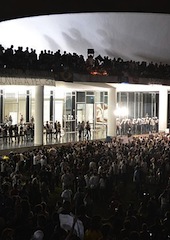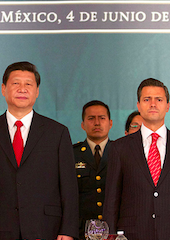Brazil: The People Vs. the Politicians
Amid mass demonstrations in Brazil, what is working and what needs improvement in the country’s political processes?
June 19, 2013

Brazil has been famously characterized as “Belindia” — a country in which a small minority of the population lived like well-to-do people would in advanced modern economies, while the vast majority lived like low-income people in India.
The captivating term was coined by my friend Edmar Bacha, who runs a Rio think tank, back in 1974.
Then, ten years ago, former Planning Minister Delfim Neto came up with another humorous epigram for Brazil, this time it was “Enghana.”
Brazil, as he saw it, had the (then extremely high) taxation level of England, but those government revenues were used to deliver social services that were at par with Ghanaian standards.
In a further twist, the Portuguese word enganar means to trick or hoodwink (taxpayers, in this case).
The implication is that nothing ever changes much in Brazil. As the saying goes, Brazil “is the country of the future, and always will be.” So what has happened to “Belindia” and “Enghana”?
In some very important ways Brazil has changed a lot over the last 10-20 years. In other ways, it has not.
From inception, the “Belindia” metaphor deliberately exaggerated the separation between low-income people and others, but it was a striking “bumper sticker” for Brazil’s extreme income inequality.
Brazil’s income inequality was for a long time among the highest in the world.
This was true until about ten years ago, when inequality began to decline year after year.
At a level of around 0.55 in Gini terms, it is now close to the level of the United States (around 0.5).
In this regard, Brazil’s remarkable evolution is reflected in the share of the middle-class, broadly defined, which rose from around 30% of the population in the early 1990s to about 55% in 2011.
How did this happen? My answer is: Brazilians were lucky to have elected two outstanding presidents — Fernando Henrique Cardoso and Luis Lula da Silva.
The first one, Cardoso, managed to curb Brazil’s perennial inflation. What is little understood is that reducing inflation is a hugely “pro-poor” policy, as poor families live on cash, which melts away by the day.
Building on Cardoso’s immense achievements, Lula’s administration expanded social services and other government support to hitherto underserved sections of the population.
Brazil recorded the steepest increase in education expenditures of all but one of OECD’s 38 countries. It rose from 3.7% of GDP in 1995 — an abysmally low level — to 5.5% in 2009, almost matching the OECD average of 6.2%.
Another important driver of social inclusion is the explosive growth of mobile communications.
Today, there are 260 million mobile phones in the country plus 40 million landlines.
Brazil is also the second biggest user of Facebook after the United States.
So “Belindia” has been dealt with pretty successfully. Alas, the “Enghana” metaphor is still valid today.
The government’s costly system of social benefits only serves a minority of the population, who are not the poor. Meanwhile, taxes are among the highest in the world.
For example, many Brazilians — in the formal economy, which often means the government sector — like to retire exceedingly early at near-full salary, to find second jobs (some actually managed to get re-hired in their old jobs).
Between 1993 and 1998, the average retirement age went down from 54 to 49 years, and the number of private sector retirees receiving government pensions nearly doubled.
The pensionable age has been raised since then, but a great many early retirees live happily in Brazil. Their pleasure is a great financial burden on the rest of society.
Owing largely to opaque, often “cascading” taxes — that is: taxes on taxes on taxes — life in Brazil is very expensive.
Brazil remains therefore a “raft economy”: A minority captures substantial social benefits, while the rest are swimming around the raft and paying heavy taxes.
This huge drain on the government’s finances has diverted funding to expensive benefits for a few from badly-needed infrastructure upgrades, and hence stunted the country’s economic growth potential.
And Brazil’s transport costs are notoriously high and were the spark that ignited the June demonstrations.
While school expenditure and coverage have increased, quality is very uneven and too many Brazilians are still only marginally literate.
The higher education system produces a fraction of the needed talent pool, notably far too few engineers to meet the country’s needs.
Last but not least, high protection against imports — a good brand-name Chinese radio costs three times what it does in Chile — depresses the population’s purchasing power.
For all its indisputable charms, Brazil has remained one of the world’s economies most isolated from the rest of the world.
Its trade (imports plus exports) adds up to less than one-quarter of GDP, half of India’s ratio and less than half of Russia’s and China’s.
The vertical axis of the following picture shows trade as a percentage of GDP; the horizontal axis shows how the ratio evolved from 1988 to 2010.
Brazil (green) was overtaken during the century’s first decade by India (purple), which during that time caught up with China (red) and Russia (blue).

Owing to its massive endowment of fertile land and mineral resources, Brazil is today one of the world’s top exporters of soy beans, orange juice, iron ore and some other commodities.
It has not, however, been successful in increasing the share of non-commodity exports, prices of which are far less volatile.
Less than 40% of Brazil’s exports are manufactures, compared to 64% of India’s and more than 90% of China’s. Of the BRIC countries, only Russia, with a rate of 15%, is out-performed by Brazil.
In conclusion, Brazil’s economy has been doing quite well thanks to a broadening of domestic demand across socio-economic strata. Inflation has come down.
And an abundance of natural resources has propelled Brazil to the top of world commodity exporters.
However, the country’s enormous public sector soaks up far more resources from society than it produces in public goods, particularly modern education and physical infrastructure.
When Brazil was selected to host the world soccer cup a year from now, and then the 2016 summer Olympics, there was great hope this looming challenge would generate the political will needed in order for Brazil truly to join the 21st century economy.
Sadly, it has not. As cost overruns and continuing corruption scandals indicate, the country’s political class remains stuck in its ways despite the valiant efforts by President Dilma Rousseff.
Read previous

Time for a U.S. Pivot to Latin America
June 18, 2013
